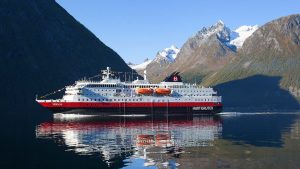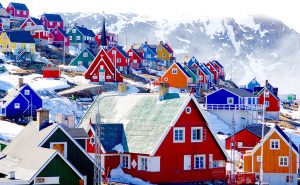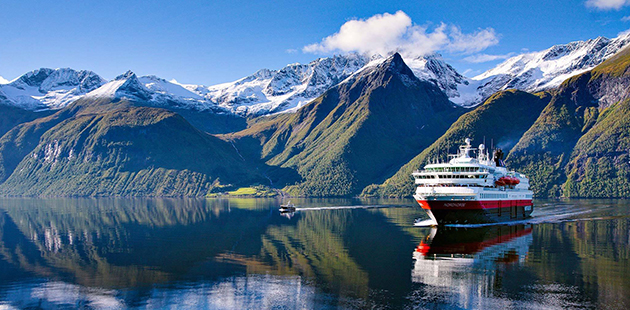Rough at the edges: Along the coast of Norway to Russia
In 1891 the Norwegian goverment challenged the nation’s ship owners to start a regular, year around post and parcel service between the small towns along the Norwegian coast; towns that were often cut off from all communications with the outside world during the long, dark and snowy winters when the sun does not show itself for weeks or even months on end. It was a challenge indeed, given the rough climate and the darkness during the winter, the lack of lighthouses and reliable sea charts at that time, the heavy winds, the strong tidal currents in the many fjords and between the 235.000 islands, which, combined, give Norway a coastline of over 60.000 miles (only the Canadian coastline is longer).

But the challenge was taken up by captain Richard Withs, who thought that a fast route (“hurtig ruten”) between these often isolated towns must be possible, also because the ports on the Norwegian coast are ice-free all year, thanks to the Gulfstream. So a regular weekly service was started in 1893, which expanded rapidly due to its immediate success.
The initial name stuck and the ‘hurtigruten’ was also discovered by traders and businessmen for visits to customers in remote areas, and soon after that also by tourists who wanted to enjoy the beauty and the rich and varied nature of the Norwegian coastline.
Nowadays, 125 years later, the ‘Hurtigruten’ has developed into a regular daily service from the lively and historic home port of Bergen, all the way to Kirkenes at the Russian border, with 32 ports of call in between; a six day trip of 1330 nautical miles (1530 statue miles or 2465 km). And the initial small ships have developed into a fleet of fourteen efficient multi-purpose ships that combine the functions of freighter, ferry for local cars and passengers, and medium sized luxury cruise ship with cabins for 158 to 640 tourists from all over the world (see www.hurtigruten.com).
The Norwegian coast has become a popular destination indeed, for during my 12-day up-and-down trip on the ship ‘Nordnorge’ (123 meters long, 11.384 BRT) I met fellow passengers from all over Europe, the USA, South Africa, Australia, Singapore, Japan and China. And for Norwegians, besides being a reliable daily ferry service along the coast and many islands, the ‘Hurtigruten’ is also a popular honeymoon voyage.
 The “Hurtigruten” voyage offers many opportunities for a wide range adventurous excursions and cultural visits: from a rough boat ride on tidal maelstroms to a romantic midnight concerto in an arctic cathedral; from a visit to salmon farms and bird watching to riding in the mountains on the characteristic, sturdy ‘fjord’ horses. Plus several trips by touringcar from one port of call to the next, through the beautiful landscape, and even to the North Cape.
The “Hurtigruten” voyage offers many opportunities for a wide range adventurous excursions and cultural visits: from a rough boat ride on tidal maelstroms to a romantic midnight concerto in an arctic cathedral; from a visit to salmon farms and bird watching to riding in the mountains on the characteristic, sturdy ‘fjord’ horses. Plus several trips by touringcar from one port of call to the next, through the beautiful landscape, and even to the North Cape.
During the summer season one can enjoy a midnight sunbath on the upper deck of the ship, while in winter one can see the magnificent northern lights; make a trip with dog sleds and visit a hotel that is built from blocks of ice and snow.

My personal favorite was the town of Bergen, which deserves a visit of a few days before or after the “Hurtigruten” trip. It is a beautiful and historic town with 260.000 inhabitants, spacious shopping streets and squares, a very lively street life, and many museums and other places of interest. Unique is the ancient ‘Bryggen’ quarter at the harbor, with its wooden houses that date back to the ‘Hansa’ period of the late Middle Ages. It is ‘a patrimony of mankind’ according to UNESCO.
My second favorite is the town of Tromsø (69.000 inhabitants), the “Paris of the North,” the “Gateway to the Arctic,” that was the starting place for many polar expeditions by legendary explorers like Roald Amundsen, Fritjof Nansen and Umberto Nobile. The town lies 220 miles above the Arctic Circle and it has several interesting museums (of which two are devoted to the Arctic and the Antarctic) and the world’s northernmost Coca Cola factory and botanic garden with many unique species from the arctic region.

(Wikipedia)
The beautiful Tromsdalen church — the “Arctic Cathedral” — organizes special midnight concertos for passengers of the Hurtigruten, with a mixture of romantic songs and music from Norway. Imagine this, while the midnight sun shines through the colored windows, or the northern lights in winter; can Grieg’s “March of the Trolls” on piano get more enchanting?
Tromsø also became famous during World War II, when Germany’s largest battleship, the feared ‘Tirpitz’, was stationed at an island just outside the town, from where it threatened the entire North Atlantic. On 12 November 1944 the ‘Tirpitz’ was bombed by the RAF, and more than 1.000 sailors died in the capsized ship. The wreck was salvaged and sold as scrap after the war.

Norway was of great strategic importance for Germany during the Second World War, not only because of the rich deposits of iron ore, but also because the Allied convoys from the USA and Canada to Murmansk passed above the country. As a result units of the German Navy and Lufrwaffe were stationed along the Norwegian coast, sea battles took place in the Arctic waters and the town of Kirkenes, only 90 miles from Murmansk, was bombed many times by the Russian air force.
The damp and chilly bomb shelters that the people of Kirkenes dug out in the rocks under their hometown, give visiting tourists an impression of the hard times during the war.
As a fan of Edgar Allan Poe, I was particularly interested in the Lofoten islands and the ill-famed “Moscoe Strom,” the violent tidal currents between the islands, where Poe located his tale A Descent into the Maelstrom. The “Moscoe Strom” can reach speeds of 14 mph, which is indeed very dangerous for sailing ships, which gave it a fearful reputation among sailors from all over the world:

“Aye, aye! and I’ll chase him round Good Hope, and round the Horn, and round the Norway Maelstrom, and round perdition’s flames before I give him up”(Captain Ahab in Moby Dick, Chapter 36).
However, Captain Roav Winther of the “Nordnorge” assured me that the maelstrom is not as deadly dangerous as described by Poe, Melville and Verne (in the final chapter of Twenty Thousand Leagues Under the Sea). But it is still a place that is avoided as much as possible by modern motorized ships, except by the Lofoten fishermen who are keen to catch the many fish, especially cod, that are brought in by the strong currents.

The chief engineer of the “Nordnorge,” Jann-Odd Steira, who lives on the beautiful Lofoten islands when he is not at sea, assured me that Poe’s description of the Lofoten landscape was surprisingly accurate. And, as a Poe student, I was delighted to find out that Poe made up three of the twelve islands between which the destructive Maelstrom rotates in his tale. The islands Buckholm, Hotholm and Otterholm do not really exist, but Poe had to add these three to make the Maelstrom into another metaphor for his favorite theme of the destructive and fatal clock (Click Here As usual with Poe, this tale has a deeper meaning than appears at first sight.
The coast of Norway is full of surprises!
(Photos by Hurtigruten unless otherwise noted)

René van Slooten is a leading ‘Poe researcher’, who theorizes that Poe’s final treatise, ‘Eureka’, a response to the philosophical and religious questions of his time, was a forerunner to Einstein’s theory of relativity. He was born in 1944 in The Netherlands. He studied chemical engineering and science history and worked in the food industry in Europe, Africa and Asia.The past years he works in the production of bio-fuels from organic waste materials, especially in developing countries. His interest in Edgar Allan Poe’s ‘Eureka’ started in 1982, when he found an antiquarian edition and read the scientific and philosophical ideas that were unheard of in 1848. He became a member of the international ‘Edgar Allan Poe Studies Association’ and his first article about ‘Eureka’ appeared in 1986 in a major Dutch magazine. Since then he published numerous articles, essays and letters on Poe and ‘Eureka’ in Dutch magazines and newspapers, but also in the international magazines ‘Nature’, ‘NewScientist’ and TIME. He published the first Dutch ‘Eureka’ translation (2003) and presented two papers on ‘Eureka’ at the international Poe conferences in Baltimore (2002) and Philadelphia (2010). His main interest in ‘Eureka’ is its history and acceptance in Europe and its influence on philosophy and science during the late 19th and early 20th centuries.

